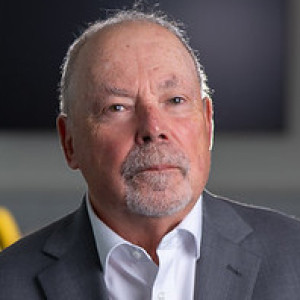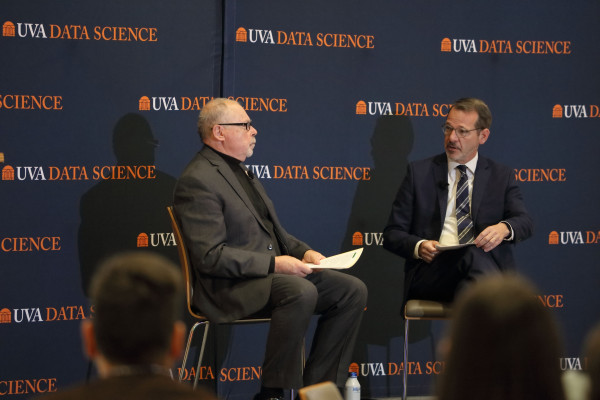Dean's Blog: Visions of Higher Ed

On March 7, I wrote a blog post on visioning the future. In this post I expand on that vision as it relates specifically to higher education. It follows our recent Datapalooza. This year’s signature event, hosted by the School of Data Science (SDS) at the University of Virginia, was devoted to that future and was where the Futures Initiative was announced by Ian Baucom, UVA’s executive vice president and provost.
In this post, I envision this future through a series of scenarios five to 10 years from now and suggest what SDS and UVA must do to meet this future. It represents an effort to be actionary rather than reactionary to events that, in my opinion, will undoubtedly reshape higher education.
Scenario 1: Translational research and public private partnership will become more important as societal problems magnify.
Consider a hypothetical example addressing climate change. Researchers from the Schools of Architecture, Data Science, Engineering and Applied Science, and the College of Arts & Sciences collectively develop a predictive model for how to refactor coastal landscapes based on a modified form of seagrass that was genetically engineered in UVA’s new Biotechnology Institute.
Advances in gene editing inspired by CRISPR, short for clustered regularly interspaced short palindromic repeats — not important here beyond knowing that it led to two women winning the Nobel Prize in Chemistry — have produced a more robust and dense seagrass with a more extensive root system that traps sand and stabilizes coastal landscapes.
The predictive model is based on extensive images from bathymetric LiDAR, which is capable of capturing the natural growth patterns of seagrass in shallow coastal waters. Based on machine learning from this imagery, predictions are made as to where and how growth can be maximized.
Working with the private sector, government agencies (e.g., U.S. Army Corps of Engineers), and local communities, theory is put into practice through a planting program. Outcomes are measured on a yearly basis, and a business model is established for more broad-based adoption of a methodology that stabilizes our coastal environment in the face of rising sea levels.
What must UVA/SDS do to meet this future? Amplify interdisciplinary research among life and environmental scientists, increase public-private partnership, and establish a culture of entrepreneurism.
Scenario 2: The scientific method will change.
AI does more than add new tools to the practice of science. According to ChatGPT-4, AI also provides new lenses through which we view the nature of scientific inquiry, the structure of scientific knowledge, the process of discovery, and the ethical landscape of science. It challenges existing frameworks and assumptions, prompting philosophers of science to rethink and refine their theories to accommodate this rapidly advancing domain. I agree.
For example, the epistemology of science will change. Humans learn through compartmentalizing knowledge into manageable chunks — witness the Linnaean Taxonomy, Dewey Decimal classification, International Classification of Diseases (ICD) — all constructed so we can get our human heads around a large body of information.
Google search, social media, and the internet negated the need for the Dewey Decimal classification. Researchers no longer go to the library and look in physical card catalogs but instead use Google search, social media, and online resources to acquire knowledge.
Taking this a step further, AI has little regard for human acts of reductionism to acquire and retain knowledge. AI considers the complete feature space and by transformation, in ways often uninterpretable by humans, generates a latent space revealing hidden factors. Taken to the extreme, the human habit of pigeonholing knowledge to make it consumable has introduced errors since knowledge does not naturally fit such schemes, but rather transcends individual classifications thereby thwarting progress. AI will remove these anomalies.
What must UVA/SDS do to meet this future? Undertake teaching and research, which are intertwined, that explores examples illustrating this new paradigm and encourages further research and teaching of the principles of explainable AI.
Scenario 3: The philosophy of science will change
In the philosophy of science, there is a distinction between scientific laws (descriptive generalizations about nature) and theories (systematic explanations of natural phenomena). AI challenges this distinction as it can create models that accurately predict natural phenomena but without the accompanying systematic explanation that would traditionally accompany a theory.
A case in point, and close to my own research heart, was the protein structure prediction problem. Elementary biology tells us proteins are the building blocks of life, and their 3-dimensional shapes define how life functions, or in the case of disease, does not function.
While we have known for a long time that proteins are composed of strings of smaller molecules called amino acids (a natural phenomena) and that the sequence of amino acids contains the information that defines how a protein folds into a 3-dimensional shape, we were unable to consistently predict that shape — we had no systematic explanation.
AI (and the folks at DeepMind) solved the protein prediction problem and were justly named the 2021 Breakthrough of the Year, according to Science Magazine.
This raises the question of whether an AI algorithm could be awarded the Nobel Prize. That aside, we still do not have a systematic explanation of why it works, but it does.
What must UVA/SDS do to meet this future? Again, undertake teaching and research, which are intertwined, that explores examples illustrating this new paradigm and encourages further research and teaching of the principles of explainable AI.
Scenario 4: Teaching and learning will change
New technologies combined with AI not only change what we learn, but how we learn. Consider an example (expanded from a previous blog):
A history major is studying the life and times of Thomas Jefferson, third president of the United States and founder of UVA. Today that involves online reading and human interpretation and possibly physical work in accessing special collections that have yet to be digitized. In a few years it will be possible to call up, via a virtual reality headset, a timeline of Jefferson’s life and a social network of whom, when, and where he interacted.
A timeline automatically generated by natural language processing. Zooming into the laying of the UVA cornerstone on Oct. 6, 1817, a simulated conversation between two former presidents, Jefferson and James Madison, and sitting President James Monroe can take place using generative AI. Looking around the small gathering using virtual reality there is a 360-degree view of what the future Academical Village looked like prior to any building occurring.
This is a simulated and possibly error-prone form of history brought to life at a price and technology point that is not here today but will be in five years.
For students, questioning and debating such events takes on a new meaning and a new form of learning in a virtual and simulated environment. For faculty this represents a new form of pedagogy and teaching in a virtual as opposed to a real world. Few teachers and learners are equipped for this future.
What must UVA/SDS do to meet this future? COVID and Zoom changed how we learn and teach. It will never revert fully to a pre-COVID time. Virtual reality that truly lives up to the name could change classrooms and indeed the demographics of our students. Already hybrid is the norm. What happens when the virtual student experience gets closer to the real one? Student demographics change. Modes of learning change. We need to prepare by prototyping courses and virtual classrooms that can meet this future.
Scenario 5: Administrative decision making will change
Currently how we think about our stakeholders is as a community, not as individuals — important as a community of practice but suboptimal in facilitating the individual, all of whom have different needs, rate of learning, mode of learning, etc.
In the future, precision is at the level of the individual and not at the level of the cohort's average. Witness efforts toward precision health. The next demand is for precision education where each student and faculty member is considered more as an individual than as one of a cohort. This will change administrative functions based on a greater amount of data on each individual stakeholder.
Consider an example: Today a student's performance is largely measured by comparison to other students and some form of standard testing. That performance is largely achieved by all students being taught the same material at the same rate. In recognition that each student is different, we introduce bootcamps, make-up classes, engage tutors, etc. The future is to study further the individual using technologies not yet available in class but in five years will be available in both the physical and virtual classroom. Such biometrics combined with other data, such as wellness (based on student health data), provide a digital footprint that can lead to improved individual learning, but with dangers to privacy and educational disparities.
What must UVA/SDS do to meet this future? Now is the time to experiment using today’s technologies with the view toward technologies, and price points to come. UVA has students and faculty willing to experiment with this future to advance everyone's ability to learn and teach while preserving their individual rights.
To conclude, writing these scenarios is a fun exercise and I could easily generate more. Words are cheap. Actions are expensive. Working together, it is the task of the Futures Initiative to make recommendations to UVA leadership on specific scenarios that mean the most to the future success of the University and to pilot them so we can get a handle on what works and what does not.
This will allow us to get a leg up on a future of higher ed that promises to be very different and will define the most successful academic institutions of the future. Prestige derived from age and tradition (e.g., the Ivy League) could be replaced by the Futures League — those schools most forward looking and training the leaders of tomorrow not the past.

